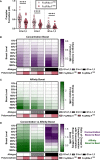A Quantitative Approach to Unravel the Role of Host Genetics in IgG-FcγR Complex Formation After Vaccination
- PMID: 35273603
- PMCID: PMC8902241
- DOI: 10.3389/fimmu.2022.820148
A Quantitative Approach to Unravel the Role of Host Genetics in IgG-FcγR Complex Formation After Vaccination
Abstract
Fc-mediated immune functions have been correlated with protection in the RV144 HIV vaccine trial and are important for immunity to a range of pathogens. IgG antibodies (Abs) that form complexes with Fc receptors (FcRs) on innate immune cells can activate Fc-mediated immune functions. Genetic variation in both IgGs and FcRs have the capacity to alter IgG-FcR complex formation via changes in binding affinity and concentration. A growing challenge lies in unraveling the importance of multiple variations, especially in the context of vaccine trials that are conducted in homogenous genetic populations. Here we use an ordinary differential equation model to quantitatively assess how IgG1 allotypes and FcγR polymorphisms influence IgG-FcγRIIIa complex formation in vaccine-relevant settings. Using data from the RV144 HIV vaccine trial, we map the landscape of IgG-FcγRIIIa complex formation predicted post-vaccination for three different IgG1 allotypes and two different FcγRIIIa polymorphisms. Overall, the model illustrates how specific vaccine interventions could be applied to maximize IgG-FcγRIIIa complex formation in different genetic backgrounds. Individuals with the G1m1,17 and G1m1,3 allotypes were predicted to be more responsive to vaccine adjuvant strategies that increase antibody FcγRIIIa affinity (e.g. glycosylation modifications), compared to the G1m-1,3 allotype which was predicted to be more responsive to vaccine boosting regimens that increase IgG1 antibody titers (concentration). Finally, simulations in mixed-allotype populations suggest that the benefit of boosting IgG1 concentration versus IgG1 affinity may be dependent upon the presence of the G1m-1,3 allotype. Overall this work provides a quantitative tool for rationally improving Fc-mediated functions after vaccination that may be important for assessing vaccine trial results in the context of under-represented genetic populations.
Keywords: ADCC; Fc receptor; Fc receptor polymorphism; HIV; IgG1 allotype; RV144; systems serology; vaccine boosting.
Copyright © 2022 Lemke, Theisen, Bozich, McLean, Lee, Lopez, Rerks-Ngarm, Pitisuttithum, Nitayaphan, Kratochvil, Wines, Hogarth, Kent, Chung and Arnold.
Conflict of interest statement
The authors declare that the research was conducted in the absence of any commercial or financial relationships that could be construed as a potential conflict of interest.
Figures






Similar articles
-
A systems approach to elucidate personalized mechanistic complexities of antibody-Fc receptor activation post-vaccination.Cell Rep Med. 2021 Sep 1;2(9):100386. doi: 10.1016/j.xcrm.2021.100386. eCollection 2021 Sep 21. Cell Rep Med. 2021. PMID: 34622227 Free PMC article. Clinical Trial.
-
FcγR Binding and ADCC Activity of Human IgG Allotypes.Front Immunol. 2020 May 6;11:740. doi: 10.3389/fimmu.2020.00740. eCollection 2020. Front Immunol. 2020. PMID: 32435243 Free PMC article.
-
Immunoglobulin G1 Allotype Influences Antibody Subclass Distribution in Response to HIV gp140 Vaccination.Front Immunol. 2017 Dec 20;8:1883. doi: 10.3389/fimmu.2017.01883. eCollection 2017. Front Immunol. 2017. PMID: 29326728 Free PMC article.
-
Antibody Functional Assays as Measures of Fc Receptor-Mediated Immunity to HIV - New Technologies and their Impact on the HIV Vaccine Field.Curr HIV Res. 2017;15(3):202-215. doi: 10.2174/1570162X15666170320112247. Curr HIV Res. 2017. PMID: 28322167 Free PMC article. Review.
-
Functional diversification of IgGs through Fc glycosylation.J Clin Invest. 2019 Sep 3;129(9):3492-3498. doi: 10.1172/JCI130029. J Clin Invest. 2019. PMID: 31478910 Free PMC article. Review.
Cited by
-
Polyfunctional antibodies: a path towards precision vaccines for vulnerable populations.Front Immunol. 2023 Jun 27;14:1183727. doi: 10.3389/fimmu.2023.1183727. eCollection 2023. Front Immunol. 2023. PMID: 37600816 Free PMC article. Review.
-
Increased SARS-CoV-2 IgG4 has variable consequences dependent upon Fc function, Fc receptor polymorphism, and viral variant.Sci Adv. 2025 Feb 28;11(9):eads1482. doi: 10.1126/sciadv.ads1482. Epub 2025 Feb 26. Sci Adv. 2025. PMID: 40009690 Free PMC article.
References
Publication types
MeSH terms
Substances
LinkOut - more resources
Full Text Sources

